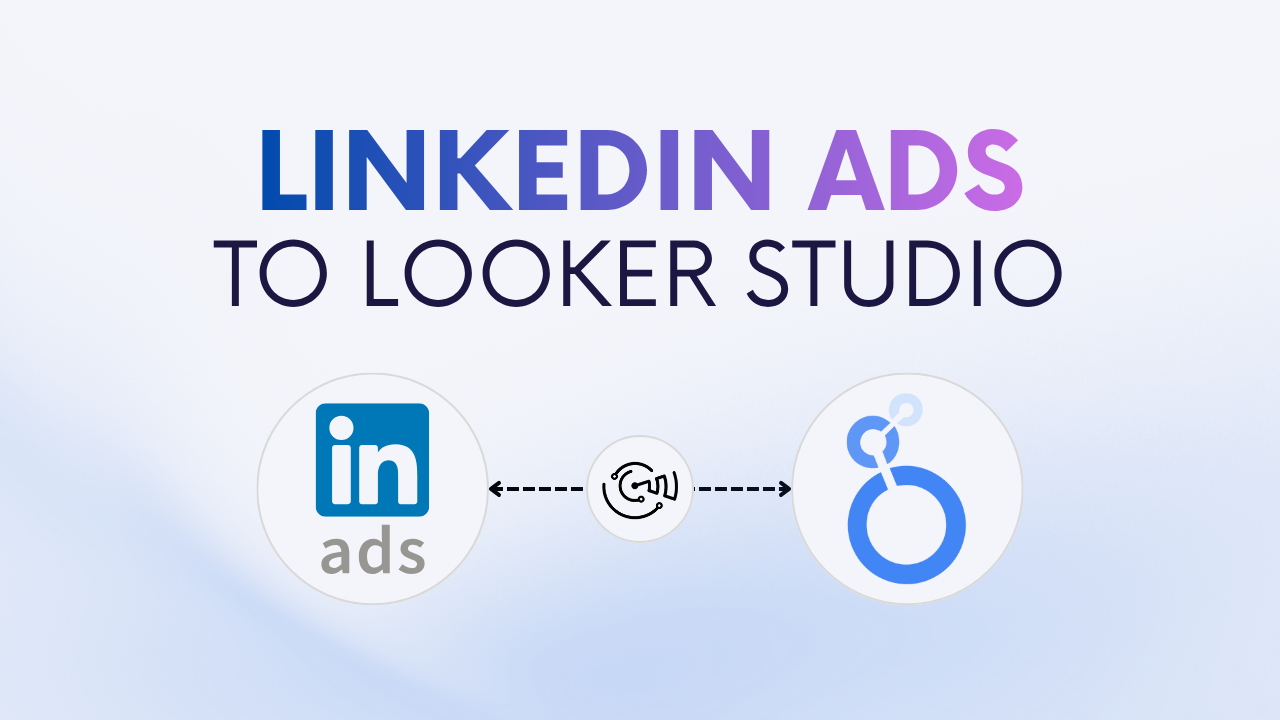Blog post
Catchr
Looker Studio
LinkedIn Ads

Looker Studio is a powerful free tool to visualize and analyze your marketing performance.
However, it doesn’t include a native connector for LinkedIn Ads, meaning you’ll need an external solution to sync your campaign data. If you want to track impressions, clicks, spend, conversions, and engagement directly from LinkedIn Ads in Looker Studio, there are two ways to do it:
Connecting LinkedIn Ads to Looker Studio gives you a single, unified view of your paid performance, so you can analyze metrics and share insights with your team or clients effortlessly.
With Looker Studio, you can:
In short, connecting LinkedIn Ads to Looker Studio transforms disconnected campaign data into actionable, always up-to-date insights.
For most marketers and agencies, the LinkedIn Ads Catchr connector is the simplest and most scalable way to integrate LinkedIn Ads in Looker Studio.
Catchr connects directly to the LinkedIn Marketing API, automatically pulling your campaign performance data into Looker Studio. Your reports update daily, ensuring your dashboards always display accurate and fresh data without manual work.
Connecting your LinkedIn Ads data to Looker Studio helps you transform campaign results into clear, actionable insights. Whether you manage ads for your own business or multiple clients, this connection simplifies performance tracking and reporting.
To help you get started faster, Catchr offers ready-to-use Looker Studio templates for LinkedIn Ads
Get a complete view of your LinkedIn Ads KPIs, impressions, clicks, spend, CTR, and conversions, with the LinkedIn Ads Global Overview Dashboard.

Analyze the quality and volume of your leads by campaign or audience using the LinkedIn Ads Lead Performance Dashboard.

Track spend, pacing, and ROI over time with the LinkedIn Ads Budget Dashboard to quickly spot overspending or optimize your campaign budgets.

If you prefer a free alternative, you can export your LinkedIn Ads data manually into Google Sheets and then connect it to Looker Studio.
From LinkedIn Campaign Manager, export your campaign data as a CSV file. Then import it into Google Sheets, where you can organize and clean the data. Next, connect your spreadsheet to Looker Studio using the Google Sheets connector.
⚠️ This method does not refresh automatically. You’ll need to repeat the export/import process regularly if you want up-to-date results.
If you manage multiple ad accounts or need dashboards that stay up to date automatically, the Catchr connector is the best option. For occasional reports or testing, Google Sheets can work perfectly fine.
Yes. Catchr supports multiple LinkedIn Ads accounts within a single Looker Studio report.
Yes. Catchr refreshes data daily, so your reports always stay up to date.
Absolutely. You can blend your LinkedIn Ads data with Google Ads, Facebook Ads, or GA4 for complete cross-channel insights.
You can pull campaign-level metrics like impressions, clicks, spend, leads, CTR, CPC, and conversions. You can also include breakdowns by campaign, audience, or ad creative. Find all the LinkedIn Ads available fields on Catchr's documentation.
Catchr offers a free trial to connect LinkedIn Ads to Looker Studio. After that, a paid plan is required for automatic data refresh and advanced automation.
Connecting your LinkedIn Ads data to Looker Studio lets you analyze performance more clearly, automate reporting, and share results with your team or clients in real time. Whether you use Catchr for automation or Google Sheets for a one-off report, you’ll save hours and gain deeper insight into your LinkedIn ad performance.

Start using Looker Studio with a ready-to-use template
Get the template
Start analyzing your data with a Looker Studio template
Catchr provides free dashboard templates to help you start analyzing your data on Looker Studio — 100+ available templates!
See all the Looker Studio templates
Start using Power BI with a ready-to-use template
Get the template
Start analyzing your data with a Power BI template
Catchr provides free dashboard templates to help you start analyzing your data on Power BI — 20+ available templates!
See all the Power BI templates
Start using Google Sheets with a ready-to-use template
Get the template
Start analyzing your data with a Google Sheets template
Catchr provides free dashboard templates to help you start analyzing your data on Google Sheets — 20+ available templates!
See all the Google Sheets templates✔ 14 days free trial — No credit-card required





✔ 14 days free trial — No credit-card required

Move your Marketing data to your favorite tools
Simplify your data extraction and move all your Marketing data to dashboard tools, spreadsheets, database and more... No code required!
75+ connectors | 20+ destinations
✔ 14 days free trial — No credit-card required

